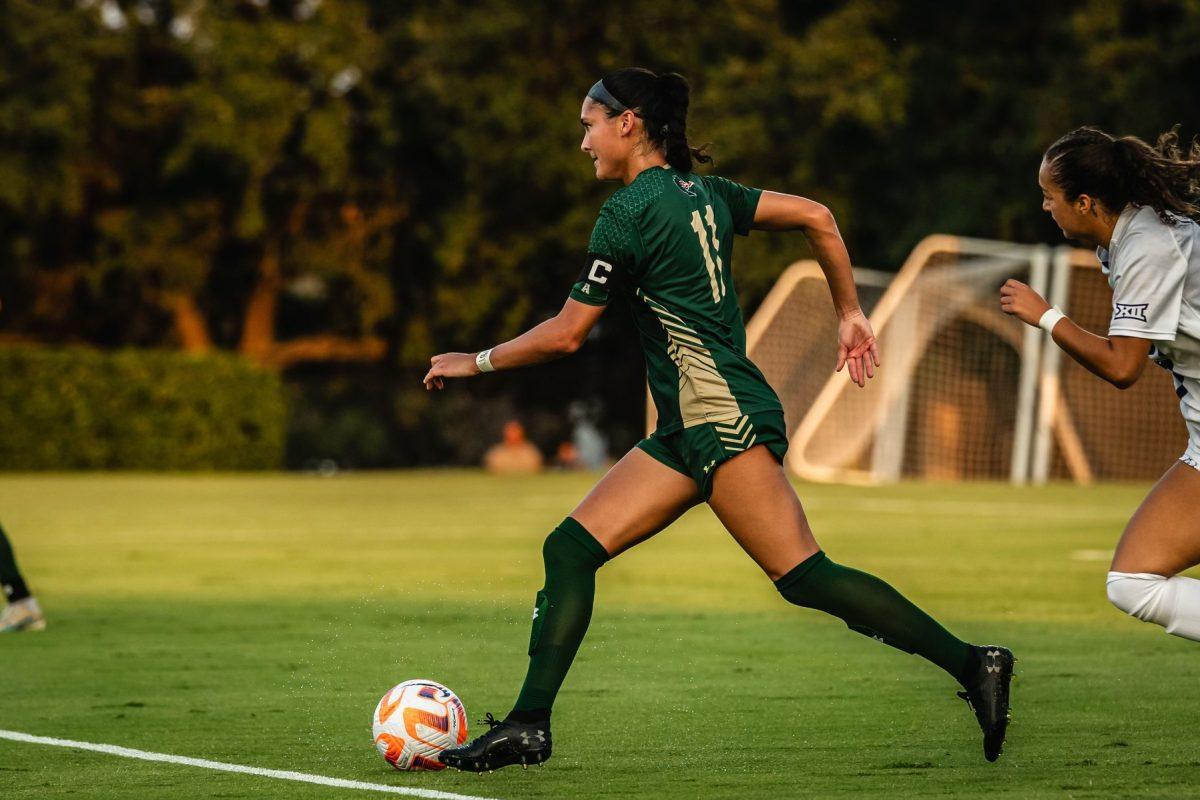
The Blazer Male Excellence Network held a silent demonstration in support of Concerned Student 1950 on November 13. (Photo by Casey Marley).
Nick Jessee – Staff Writer
[email protected]
Sarah Faulkner – Features Editor
[email protected]
A silent demonstration in support of Concerned Student 1950 took place Friday, Nov. 13, in front of Heritage Hall. Hosted by the Blazer Male Excellence Network, the demonstration addressed racism and discrimination, responding to the situation at the University of Missouri and expressing support for Concerned Student 1950.
Formed by University of Missouri student body president Payton Head, Concerned Student 1950 is a group that utilizes peace as a tool for spreading awareness and to fight discrimination. 1950 references the year that the University of Missouri admitted its first black student, paying homage to the university’s history of segregation. Students who identify as part of the Concerned Student 1950 group hope to express support for institutionalized diversity and stand against discrimination in educational settings.
According to BMEN’s lead mentor, USGA President Garrett Stephens, the goal of UAB’s silent demonstration was to get pictures of students standing together in support of Concerned Student 1950 and, through multiple social media outlets, spread the support and strength to others across Birmingham, the state and anyone else seeing it.
Stephens felt that it was important for UAB students to demonstrate solidarity with the University of Missouri students as awareness of racial inequality. “With Birmingham’s history and large student of color population at UAB, and with things happening at UA, we think it is important to show support,” Stephens said.
“I’m very proud to see that my school supports Mizzou and that we are concerned for those students that are feeling threatened and for what’s happening on campus,” Taylor Byas, a junior English major from Chicago, said. The demonstration at UAB showed its awareness and proactivity in peacefully demonstrating against inequality. “These demonstrations help students know they have a support system. So being proactive, instead of reactive, is shown at school. We want to be ahead of it,” Stephens said.
“I think UAB handled the situation the best way they knew how, which was by showing their support and telling [the students of the University of Missouri] that they aren’t alone in this fight,” Brequia Bozeman, a senior, said.
However, for some students, while a step in the right direction, there is still more to be done to combat racism in educational institutions.
“I haven’t seen racism first hand at UAB, but that doesn’t mean it isn’t present,” said Elizabeth Reid, a junior and member of the Women for Political Progress club. “I recently went to the ‘Black Enough’ panel discussion and was surprised at how minimal the presence of white people were, or people of any other racial ethnicity for that matter. A majority of the people there were African American but I think people of all races should participate in attending discussions such as these to understand different points of view.”
“I love that we, along with many other schools across the country, posted pictures of our students coming together and showing that support. But it’s fairly easy to take a picture and post it. What isn’t easy it to take action,” Byas said. “I know that there are ISU [Iowa State University] students that are planning to take trips to Mizzou on the 30th of this month to protect those students. To show up and give them strength in numbers. To be a physical barrier to those threatening those black students’ lives and making them feel unsafe. What’s stopping us from making trips? What is stopping us from going further than posting a picture, actually reaching out to those students? They need more support.”
Others felt that UAB wasn’t doing nearly enough to recognize racial inequality or properly express its solidarity.
For example, Kellan Hyde, a sophomore communications major, wasn’t aware of the silent demonstration due to “lack of publicity.” However, she said that she wasn’t surprised that she didn’t know about it.
“I feel like anything social justice-y isn’t ‘popping’ here,” Hyde said. “Perhaps UAB could do more because I don’t ever hear of UAB doing anything to stand with anyone else.”
“Maybe they didn’t want it to be heavily publicized for fear of authorities shutting it down? In my opinion, that defeats the purpose though,” Reid said, speculating on the lack of publicity that led her to miss the demonstration, which she “really wished [she] would’ve known about because [she] would’ve most definitely participated.”
As of Fall 2014, 21 percent of UAB’s undergraduate population identified as African American, according to the Office of Institutional Effectiveness and Analysis. This is significantly larger than the combination of both the University of Alabama’s African American population, which constitutes 12 percent of the total student body, and Auburn University’s African American population, which constitutes seven percent of the total student body.
While UAB’s African American student population is large compared to other in-state universities, Bozeman said that she felt like “the black population is underrated and that [they] don’t do as much within the school and the things that are being done by [them] don’t get as much recognition as others.”
Byas felt UAB would potentially ignore the population if events similar to those in Missouri occurred.
“I’m pretty sure if we were experiencing some of those things [that Mizzou is facing], there would be some UAB professors that would still have exams and disregard the fact that their students didn’t feel safe coming to class. I’m pretty sure we would have some nonchalant administrators that would turn their heads the other way,” Byas said. “I don’t know how diverse Mizzou’s campus is and UAB’s diversity is one of the things I love about the campus. But at the end of the day, this is a PWI [Predominantly White Institution]. And I truly believe we would run into some huge problems if racist incidents of that caliber started to take place here at UAB.”
Stephens said that he wants students to be informed that the Student Multicultural Diversity programs here do a lot of work informing students and helping them with education and diversity at universities.
“The Student Multicultural and Diversity Programs within the Office of Student Experience continuously plans programs and dialogue that promote awareness, education, and nondiscrimination,” said Brandon Cohill, the Vice Lead Mentor of BMEN and an organizer of the BMEN demonstration.
The silent demonstration on Nov. 13 was only a piece of the support for diversity and the stand against racial discrimination. According to Cohill, there will be a forum for students to address their concerns at UAB on Wednesday, Nov. 18 at 7 p.m.
“I personally believe that UAB does a good job of making the campus a safe place for people of all ethnicities and cultural backgrounds,” Reid said. “There are so many diverse organizations on campus. In fact, the number one reason I chose to attend UAB was because of how diverse the campus is.”
EDITOR’S NOTE-CORRECTION AND APOLOGY:
Kscope would like to thoroughly and formally apologize for the misquotation of Garrett Stephens in this article. In our print edition, the article quoted Stephens as saying “large population of colored students.” This was a transcription error. Upon learning of the mistake, we changed his quote to “large student of color population”—his correct statement on the online version.
We cannot change the words of the print edition, but the entire Kaleidoscope staff would like to apologize for this ignorant mistake and any offense that may have been taken from the misquotation.





































